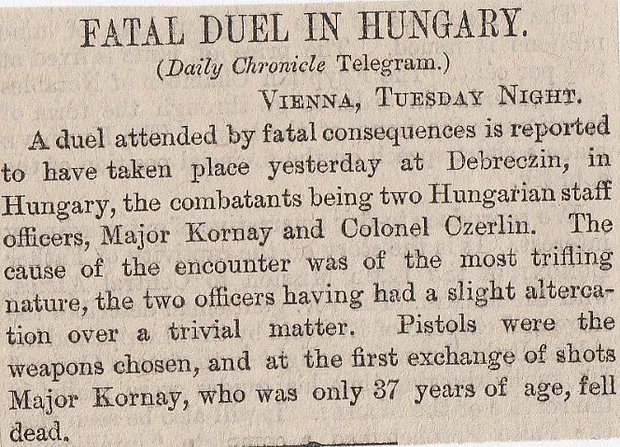1/ Timisoara, Romania, February 1897
Eighteen women were arrested on suspicion of a mass poisoning of their husbands. Their bodies are to be exhumed and tested for poison. Similar to Hungarian husband poisoning club in 1880.
2/ Budapest, Hungary, (Infant in Bread) December 1891
This is one of the sickest ways I’ve heard of to get rid of a dead body! Someone was tucking into some bread, crunched into it and found some small fragments of flesh and bone of an infant. It had been minced up and kneaded into the dough and then baked and distributed throughout Budapest.
3/ Dyatlov Pass, Russia, February 1959
Definitely Russia’s greatest unsolved mystery. A group of nine students go off on a hiking trek in the Ural Mountains, then when nobody sees or hears from them, the Soviet’s send out a rescue team. What they find is a scene of utter carnage. Firstly the bodies were not grouped together, they were spread kilometres apart with some semi-nude and some wearing one another’s clothes. One party had been found in a ravine, all four had been severely beaten and indeed arms and legs were broken, including one girl with a missing tongue. The tents had knife marks cutting from the inside out, there was a set of footprints (barefooted)in the snow. Who the hell would go to such lengths? A group of pissed up locals? Could one of the students gone on an Anders Breivik style rampage?
It appears whatever scared these students, it was enough to make them cut open their tents, grab a handful of clothes, no matter whose they were and go into the sub-zero temperatures. Whoever or whatever did this did one hell of a job. Nearly sixty years later no one has thrown any light on the mystery.
4/ Cape Elia, Cyprus, (Sphinx Tragedy) April 1878

upsetting of one of their stoves. The Sphinx is completely destroyed from bow to midships and all that is expected to be saved is the engine.
5/ Bulgaria/Turkey, December 1904 (Steamer Sinks in the Black Sea)
A violent south-westerly gale and storm which prevailed in the Black Sea and Sea of Marmaris from the 15th to the 20th of November caused huge damage on land and at sea. The steamer “Elpis” of the New Hellenic Steam Navigation Co, with seventy passengers and general cargo, was lost in the Black Sea and it feared that all passengers and crew went down with her.
6/ Poland Family Murdered, December 1872
In the Russian (it was then!) village of Osowiec, in the Government of Grodno (Belarus), a rich timber merchant named Apfelbaum and all his family, numbering fifteen persons, have been murdered in the night by a gang of robbers. After taking all the money they could find the robbers burnt down the cottage. Six persons have been arrested, but the gang is said to have numbered around twenty men.
7/ Gleboka Jewish Family Murdered, Ukraine, September 1885 (Actually Gleboka, Lviv, Ukraine)
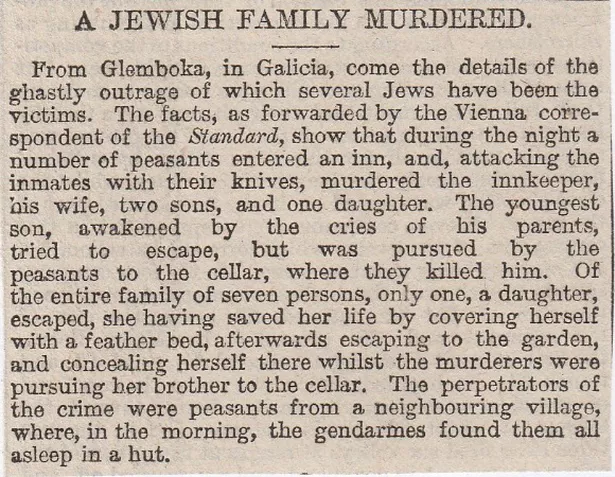
8/ Friedland (Frydlant, Czech Republic January 1899 (Suicide with Dynamite)
At Friedland, a country town in Bohemia, now in the Czech Republic, an elderly man of sixty, Francis Stern, lay on his sofa then lit a stick of dynamite and put it on his chest. As you can well understand there wasn’t much left of old Francis, as when he was found there were bits of flesh, blood and bone spread on the walls and floors of his flat. I think his theory was, that it was a guaranteed way to kill himself.
9/ Kirwan Colliery Explosion (Now Karvina, Czech Republic) March 7th, 1885

10/ Kirwan Colliery Explosion, now Karvina, Czech Republic March 9th, 1885

11/ Near Lake Van, Armenia, (Avalanche- 63 Dead) May 1885
According to a telegram from Constantinople, there has been a terrible avalanche in the Ala Dagh mountains near Lake Van in Armenia. A caravan numbering seventy-five persons, which was passing at the time, was swept away and nearly annihilated, no fewer than sixty-three of the company having lost their lives.
12/ Saratov, Russia, (Brutal Lynching) December 1879
In a village, two Tartars were lately seized in the act of stealing a sack of flour from a barn and were shut up all night. Early next morning the whole population of the village assembled and condemned the two culprits in a manner which would have done credit to the most ingenious torture inventor. The unhappy men were first bound to poles and beaten with clubs, till their legs and arms were broken. Then the bleeding victims were tied to the tails of horses and dragged over the frozen field until dead, their bodies being afterwards flung over a precipice. The newspaper does not say whether the murderers were called to account.
13/ Koenigsberg Murder, (Now Kaliningrad, Russia) March 1899 (Sorry, bit clumsy with the scissors!)

14/ Cilli Stage Suicide, Styria, (now Celje in Slovenia) March 1899
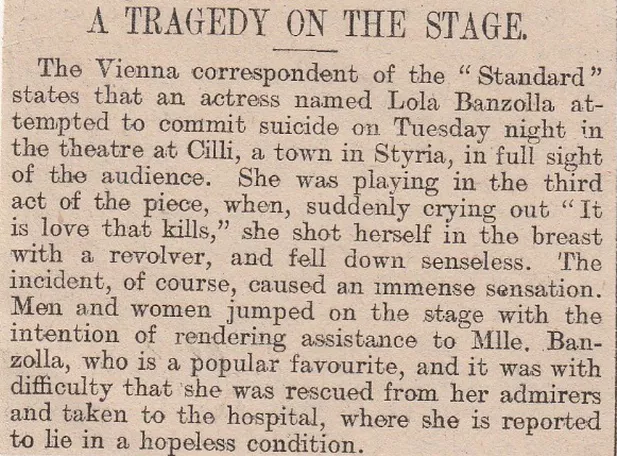
15/ Troppau now Opava, Czech Republic and Ostrau is now Ostrava, Czech Republic, March 1885
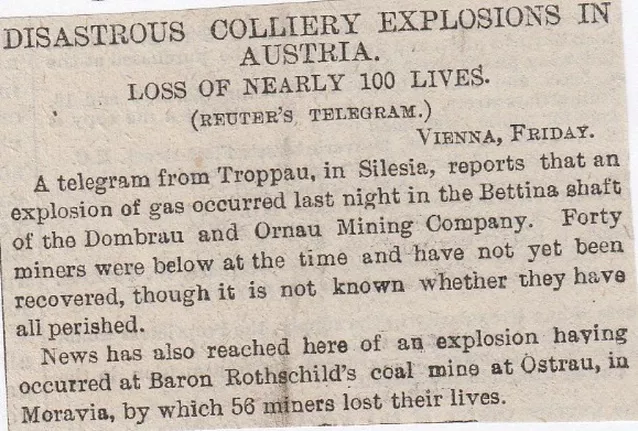
16/ Drvenik, Croatia, November 1890 (Croatian Customs and Beliefs)
This story gives an insight into the widely held customs and beliefs of the Croatian people in Victorian times. About a year ago, late October 1889, two sisters, aged eighteen and fifteen, were sitting on the rocky coast near Drvenik, sheep herding, when their cousin, Spiro Drazic, encountered them on his way to chop wood in the forest. The elder sister went to gather the stray sheep after he had left them and was gone for around fifteen minutes. When she came back she found the younger sister in tears saying that while she’d been shepherding, Spiro had “dishonoured her” and that she was going to drown herself in the sea. Literally, as she finished the sentence, she ran to the cliff edge and plummeted over, into the sea. The sister told this story and a local priest said that girls from this neck of the woods consider themselves to have been violated, even if a man touches her breast. This is exactly what the sister told the family, that Drazic had touched her breast. The jury came to the conclusion that Drazic was responsible for her death and he got twelve years in prison. However, he was retried and this time he ended up with a one year sentence of imprisonment.
17/ Posarevatz Romantic Tale, (Now Posarevac, Serbia) June 1895

18/ Gleiwitz (Now Gliwice, Poland) July 1889
A terrible explosion caused by an accumulation of foul gas in a furnace occurred on Thursday at Count Donnersmark’s ironworks near Gleiwitz, Germany. Five workmen were killed outright and several others were severely injured.
19/ Angerburg, Germany (Now Wegorzewo in Poland) (Bricked Up Alive) October 1893
A frightful discovery was made at Angerburg (Wegorzewo), while excavations were being carried out underneath a church there. The labourers found a walled-in space, inside of which, was a human skeleton, a broken chair along with the remnants of a helmet and a pair of boots. The wall had scratch marks on them, as though the prisoner had clawed at the bricks and mortar, in a desperate bid to get out. It is all too evident that a person had been bricked up alive.
20/ Liptau, Hungary, (Now Liptov in Slovakia) April 1885 (Persecution of Jews)
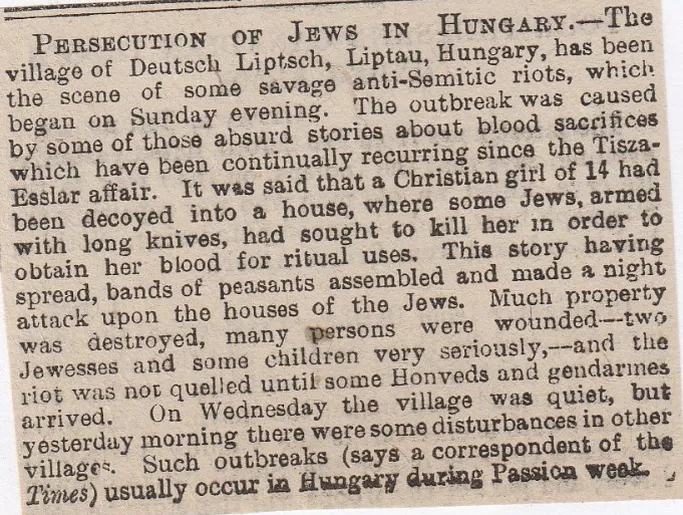
21/ Guta, Hungary, (Now Kolarovo in Slovakia) April 1899
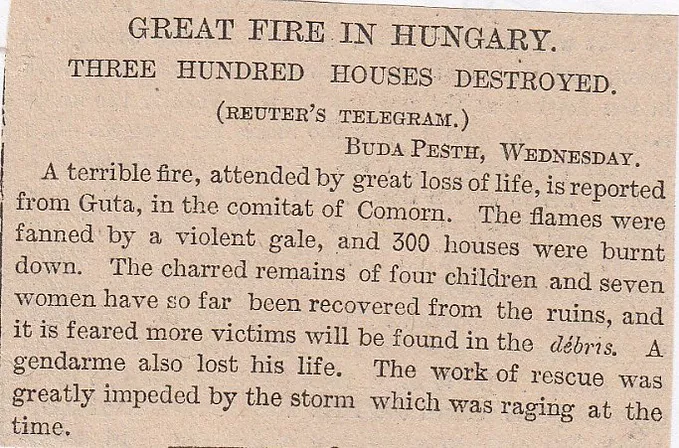
22/ Warsaw Mass Infanticide, Poland (Angel Factory)February 1890
No less than seventy-six cases of infanticide were found to be the work of a woman named Skublinsky from the Polish capital, Warsaw. She was aided and abetted with the help of her son, who carried the dead infants out in a basket. The heartless bitch also slept and dined in the same room as she kept the decaying bodies in a stove. It was called an “Angel Factory”, whether that is an orphanage of sorts or a baby farm, I’m not altogether sure. (Anybody know what an “Angel Factory” was?)
23/ Poland? April/May 1899 (Mine Disaster)
A telegram from Warsaw stated that a terrible disaster had occurred at a gold-mine in Troigh?. A shaft where ninety-nine men were working, collapsed owing to an inrush of water and sixty-two of them were killed. The remainder were rescued with great difficulty, most of them having serious injuries. (Where is Troigh?)
24/ Rzecze (Volhynia is on the Poland/Ukraine border) August 1892
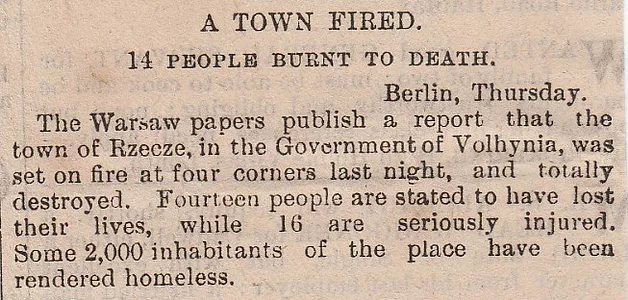
25/ Budapest, Hungary, October 1889
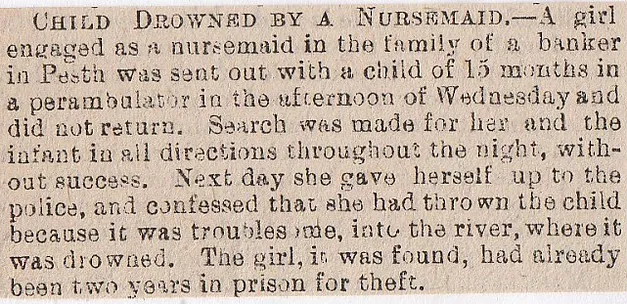
26/ Vagankovo Cemetery, Moscow, Russia June 1890 (Suicide on Husbands Grave)
33-year-old Marie Aksenow killed herself on her husband’s grave in Vagankovo Cemetery, Moscow, in an act of self-immolation. Aksenow carried a small cask of kerosene with her to the grave, then doused herself in it and set herself on fire. The cask also caught fire and it blew up. The cemetery gravediggers ran to try and save her but she was burnt to a crisp by the time they arrived. Ever since the death of her husband six months ago, she had suffered from depression and had tried to kill herself on many occasions.
27/ Yeniseysk, Russia, February 1899 (Balloon Crew Found dead in Siberia)

28/ Itzkany Explosion, (Now Itcani in Romania) March 1895
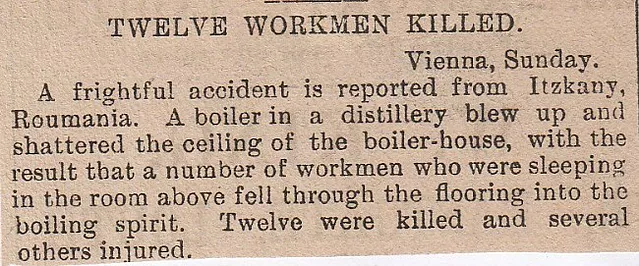
29/ Bucharest, Romania, August 1889 (Double Suicide)
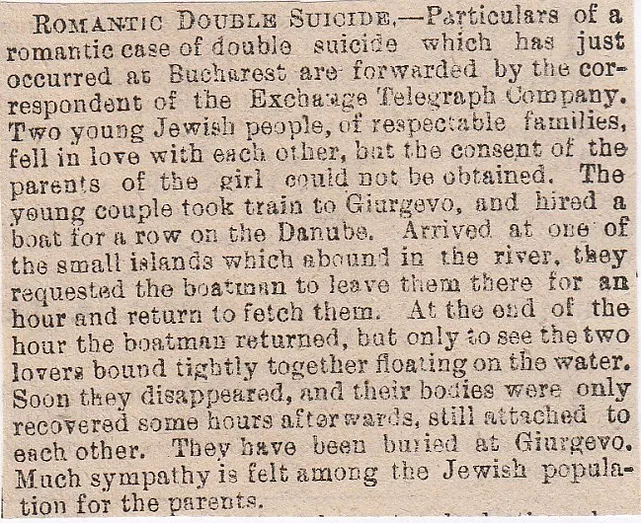
30/ Nagy Bobrocz, Slovakia, (Great Fire) February 1899
During a gale which blew last night what proved to be a destructive and fatal fire broke out in the village of Nagy Bobrocz, in the county of Liptau (Liptov). The flames fanned by a high wind, spread with rapidity, which defied all efforts to master them and in a short space of time no fewer than three hundred houses were reduced to ashes. A number of villagers lost their lives while endeavouring to save their property.
31/ Cracow, Poland, September 1885 (Jewish Murder Trial)
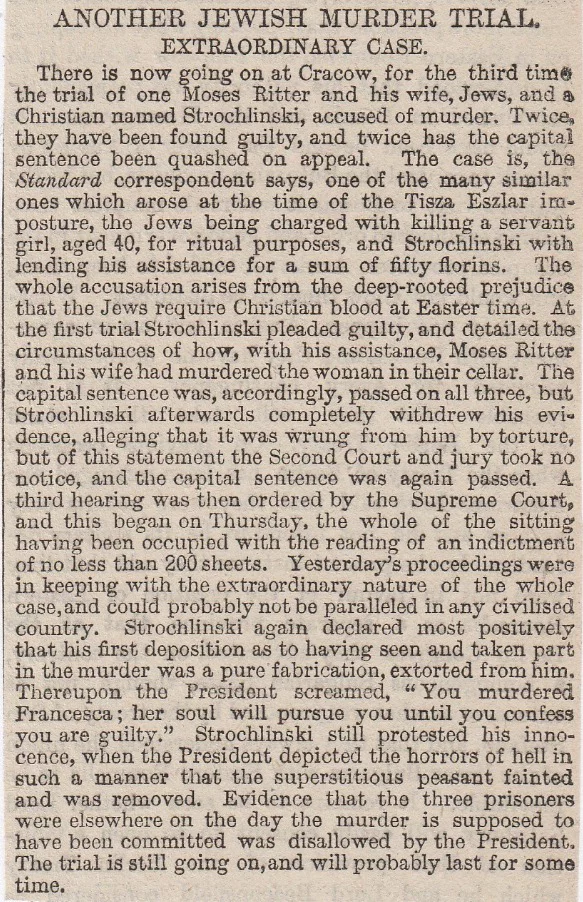
32/ Stettin is now Szczecin, Poland (On German border) June 1899
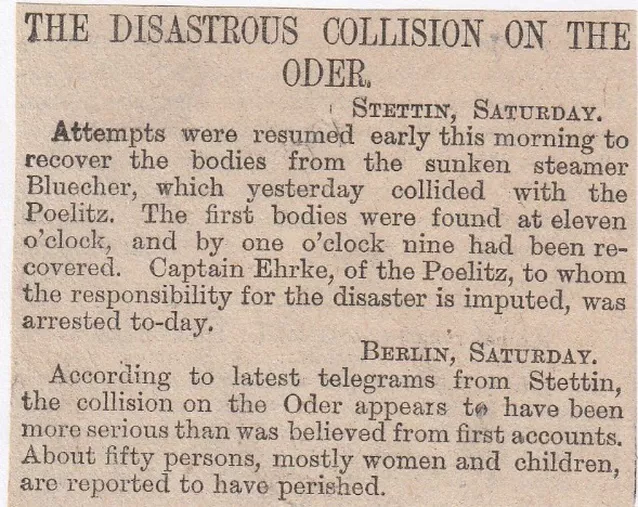
There were several dozen school-children from the Stettin area on board the boat that day. Around thirty are supposed to have perished in the collision. They stood little or no chance, as the Blucher sank within a few minutes. Captain Ehrke of the Politz, who is said to be responsible for the accident, was arrested. (What happened to Captain Politz?/What the end death toll?)
33/ Szerdahely, Hungary, January 1880 (Husband Poisoning Club)
This is probably my favourite story in the East Europe section. A Husband Poisoning Club was formed. A number of suspicious deaths had been happening in the Szerdahely district, with eight married farmers dying in the last six weeks. Such an instance in a city or major town would be looked into thoroughly, but out in the sticks of rural Hungary, it was put down to a coincidence. It got so bad that the authorities decided to make a thorough inquiry into the matter. The post-mortem reports and death certificates said the men died from a fever, but it was actually arsenic poisoning. It was cooked up from a rat poison and had been put in the men’s wine, the coffee etc. The discovery of a husband poisoning club amongst the “merry wives” of the neighbourhood was a major coup for the police. Mainly they wanted to be rid of their drunken husbands who didn’t work and relied on the women to support them and secondly, they did it for the insurance money.
Szerdahely, 1882
52-year-old Kathi Lyukas or Kate Nagy as she was better known, who murdered a couple of her husbands and confessed to another six murders. Lyukas was suspected of killing twenty, by putting arsenic into cakes and giving them to whoever they wanted to die. She was hanged at Stein-am-Anger, now Szombathely in Hungary near the Austrian border) in November of 1882. (Was she the sole member of the “Husband Poisoning Club”, doing it for cash?)
34/ Hungary, October 1889 (Mother Kills Six of Her Children)

35/ Debrecen, Hungary, (Fatal Duel) July 1885
